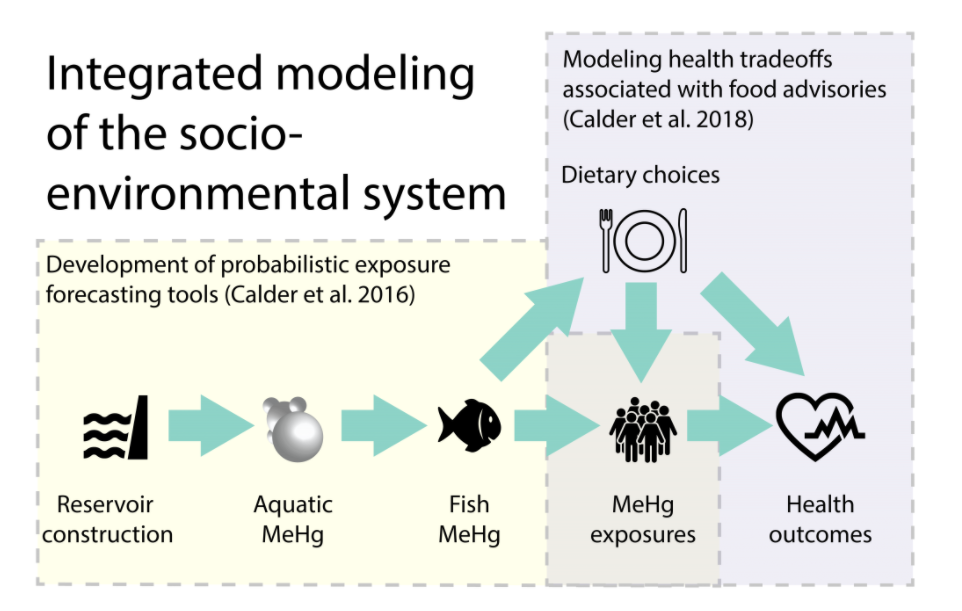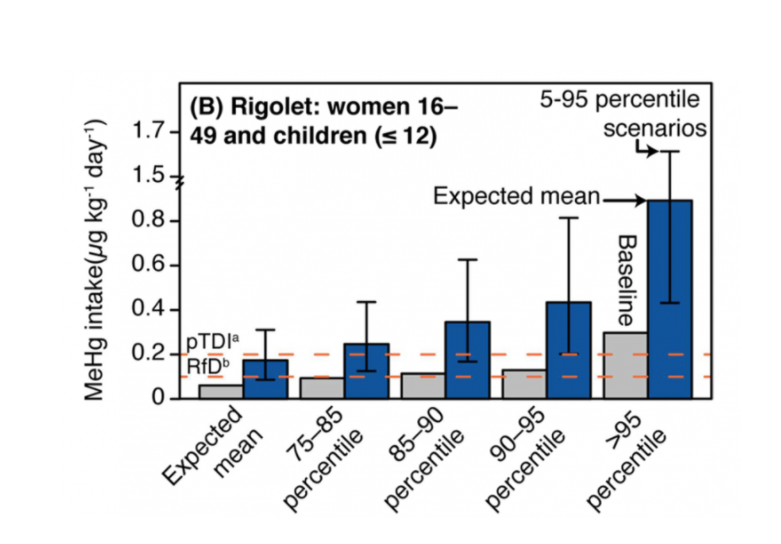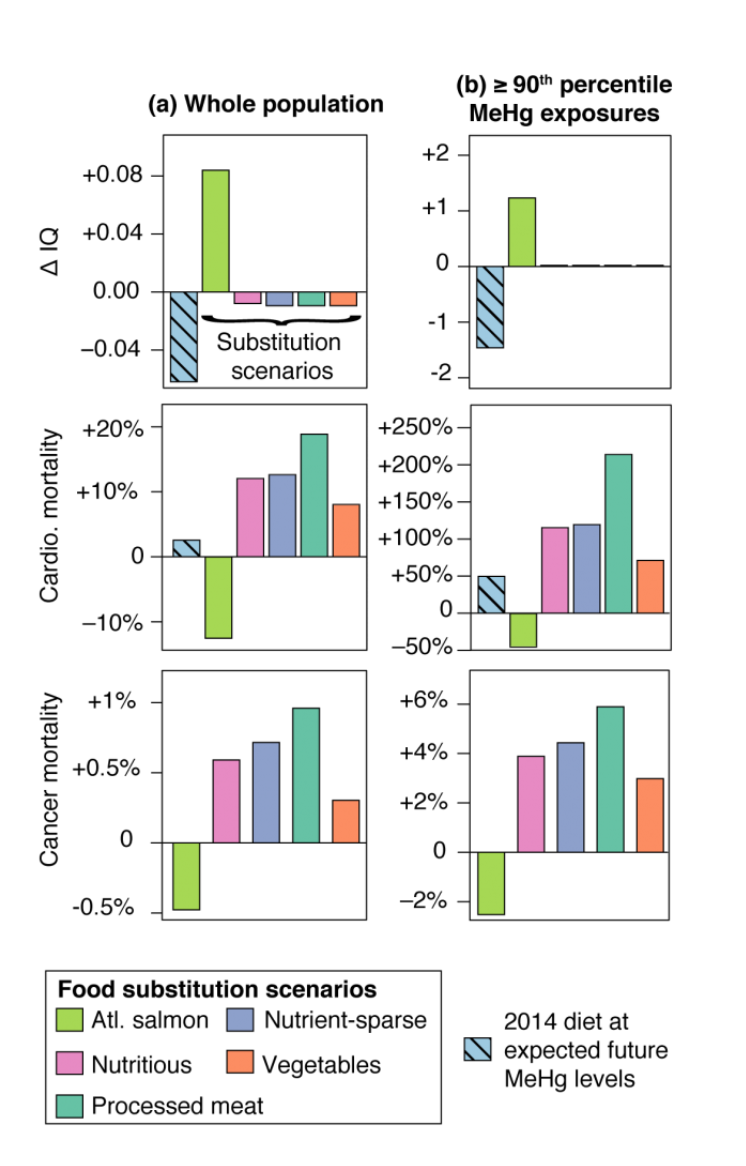Hydropower and Indigenous health
Reservoir creation associated with hydroelectric power development accelerates the production of neurotoxic, bioaccumulative methylmercury (MeHg). This poses a risk for Indigenous populations and other consumers of seafood from environments affected by reservoirs. However, seafood is a healthy dietary alternative, especially for Indigenous populations who suffer from high rates of food insecurity.

This work synthesized the state of the science of MeHg biogeochemistry, toxicokinetics and epidmeiology into an integrated modeling framework to describe the likely range of human health impacts (based on current understanding) as a function of environmental conditions, reservoir design and local human diets. The mechanisms responsible for production and accumulation of MeHg in aquatic ecosystems and its health impacts on humans are the subject of ongoing research, and so this work is subject to re-evaluation as underlying science evolves.
Probabilistic MeHg exposure forecasting
This work leverages advances in environmental chemistry to create probabilistic risk forecasting tools for complex aquatic environments that can be used to screen potential impacts on human MeHg exposures.We developed a model to describe the impacts of MeHg released from an upstream reservoir on the food web in a downstream estuarine fjord as a function of local conditions and reservoir characteristics.
We developed this analysis around the case of the Labrador Inuit, settled downstream from the Muskrat Falls hydroelectric generation facility.
1,145 Inuit participated in a dietary survey and exposure assessment to calculate the potential exposure impacts of upstream hydroelectric development. The Inuit community offered research assistants to carry out the work and guided the development of the study protocol.
Food advisories and health tradeoffs
It has long been acknowledged that traditional foods are disproportionate sources of both nutrients and contaminants among Indigenous populations. However, a lack of quantitative understanding of the risks and benefits of traditional foods, in comparison with alternatives, have meant that food advisories have typically been confusing and contradictory.
We created a database of nutrient profiles in all foods in the Inuit diet (traditional, local foods and store-bought foods) and compiled confounder-adjusted dose-response relationships for foods, nutrients, and MeHg based on latest epidemiological studies. We combined these to evaluate the net health impacts of 1) increased exposures to MeHg at present-day diet compared to 2) several hypothetical dietary changes that people may make in response to food advisories or fears over the quality of local foods (for example, replacement of local foods with store-bought alternatives).
We found that the risks of reduced traditional food consumption generally outweigh the risks of increased MeHg exposures and that there is room within the traditional diet to improve outcomes relative to today even with greater MeHg exposures (eating more nutrient-rich local species such as salmon).
Publications
2018 RSD Calder, S Bromage & EM Sunderland. ‘Risk tradeoffs associated with traditional food advisories for Labrador Inuit’ in Environ Res, vol. 168, pp. 496–506. ➥
2016 RSD Calder, AT Schartup, M Li, AP Valberg, PH Balcom & EM Sunderland. ‘Future impacts of hydroelectric power development on methylmercury exposures of Canadian Indigenous communities’ in Environ Sci Technol, vol. 50 (23), pp. 13115–22. ➥
2015 AT Schartup, PH Balcom, AL Soerensen, KJ Gosnell, RSD Calder, RP Mason & EM Sunderland. ‘Freshwater discharges drive high levels of methylmercury in Arctic marine biota’ in Proc Natl Acad Sci USA, vol. 112 (38), pp. 11789–94. ➥
2016 AT Schartup, RSD Calder, M Li, PH Balcom, AP Valberg, J Ewald & EM Sunderland. ‘Methylmercury’ in A Durkalec, T Sheldon & T Bell (Eds.), Lake Melville: Avativut, Kanuittailinnivut: Scientific Report, pp. 49–61. Nain, Canada: Nunatsiavut Government. ➥
2021 RSD Calder, AT Schartup, T Bell & EM Sunderland. ‘Muskrat Falls: Methylmercury, food security, and Canadian hydroelectric development’ in Muskrat Falls: How a Mega Dam Became a Predatory Formation by S. Crocker & L. Moore (Eds.), St. John's, Canada: Memorial University Press. ➥
2020 RSD Calder. ‘Coupled human-natural modeling for hydroelectric development: understanding the health impacts of America's renewable energy imports’ in M. Valerino (Ed.). Case Studies on Energy Access Transitions in the Developing World. Durham, NC: Duke University. ➥
2019 RSD Calder, ‘Health impacts forecasting to guide hydropower design and policy’, Jones Seminar Series, Thayer School of Engineering, Dartmouth College, Hanover, NH. ➥
2018 RSD Calder, AT Schartup, M Li, AP Valberg, PH Balcom, S Bromage & EM Sunderland. ‘Forecasting human health impacts of reservoir creation and food consumption advisories: an integrated model to guide hydroelectric development’, Association for the Sciences of Limnology and Oceanography, Victoria, Canada. ➥
2016 RSD Calder, AT Schartup, M Li, AP Valberg, PH Balcom & EM Sunderland. ‘Future impacts of hydroelectric power development on methylmercury exposures of Canadian Indigenous communities’, Society of Environmental Toxicology and Chemistry, Orlando FL. ➥
2019 RSD Calder. “Muskrat Falls hydroelectric project poses risks for Canada that are being ignored”, The Conversation; republished as: ‘Canada ignore Muskrat Falls at its own peril’. The Telegram, St. John's, Canada. ➥
2019 RSD Calder. « Une mauvaise publicité pour l’hydroélectricité québécoise » (‘Bad advertising for Quebec’s hydropower’). La Presse, Montreal, Canada. ➥
Collaborators
Acknowledgments

This work was carried out in the Biogeochemistry of Global Contaminants lab at the Harvard John A. Paulson School of Engineering, directed by Prof. Elsie Sunderland. The Nunatsiavut Government actively facilitated our health study. We also acknowledge funding received through NIH, NSERC, NSF, and ArcticNet.




